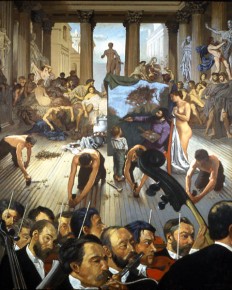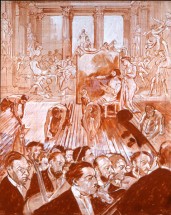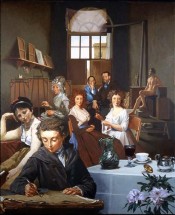| WorkLe Musee d'Orsay
| Image Notes
Reference Couture, The Romans of the Decadence, 1847. Courbet, The Painter's Studio: A Real Allegory, 1855. Caillebotte, The Floor Scrapers, 1875. Degas, The Orchestra of the Opera, 1868. | Artist's Notes
Click highlighted words for images and information
Del Sarto Canaletto Titian... has started me on a new series of paintings. The first was The Studio of Jacques Louis David, a big 70 by 58 inch painting with figures from Corot to Degas sitting about in David's studio. The second painting is The National Gallery, Washington, with figures from paintings in the collection assembled around the fountain in the rotunda of the National Gallery and with a Fantin-Latour still life up front. I am now working on The Musee D'Orsay, Paris. It too will be a 70 by 58 inch canvas, the same size as the others, a suitable museum-size format. (George Deem, letter to Patricia Williams, November 29, 1996). I continue to work on both the Seven Vermeer Corners and the Musee d'Orsay. (With the latter) I have repainted the Degas orchestra section to reduce the size of the heads and bring more of them into the painting. In the process I have also reduced the size of the scroll and pegs of the bass viol so that it does not intrude into Courbet's space. It was disproportionately dominant when you saw the painting. I am very pleased by what you wrote about this painting, seeing Couture through Courbet and both through Caillebotte and all three through Degas. In your letter you refer to this work as my "French school painting" and that is of course what it is. These new collection paintings extend ideas I began developing in the "School of ..." paintings. In the Musee d'Orsay it is a 19th-century French school of painting that I am orchestrating. (George Deem, letter to Christiane Hertel, March 10, 1997) Le Musee d'Orsay listens in on the unending conversation of pictures with other pictures through time. I quote four key works from this Paris museum's collection of nineteenth-century French paintings. Couture's Romans of the Decadence (1847) borrows from Raphael and Veronese to make a challenging statement of faith in the long tradition of painting. Courbet responds to that statement with another epic painting, The Painter's Studio (1855), which he combatively subtitled "A Real Allegory." His painting is populated with the figures of "real" people, the contemporary artists and writers who were part of his circle. Courbet has positioned himself at the center of his painting in a self-portrait of the painter seated before his easel. I have quoted Courbet's central group of figures: the seated artist, his model, and the boy standing at the artist's knee. The group of musicians is from The Orchestra of the Opera (1868) by Degas. I have removed the stage and orchestra pit in his painting to make way for the floorboards in Caillebotte"s Floorscrapers (1873). The floorboards are lit from the columned atrium of The Romans of the Decadence, and I have added the figure of a fourth floor scraper. The point where Courbet's paint-laden brush touches the canvas on his easel is the exact center of my composition in which one may see Couture behind Courbet, and Courbet through Caillebotte and Degas. (George Deem, How To Paint A Vermeer: A Painter's History of Art, Thames & Hudson, 2004 (20). |
Works
| WorkLe Musee d'Orsay
| Image Notes| Artist's Notes |




